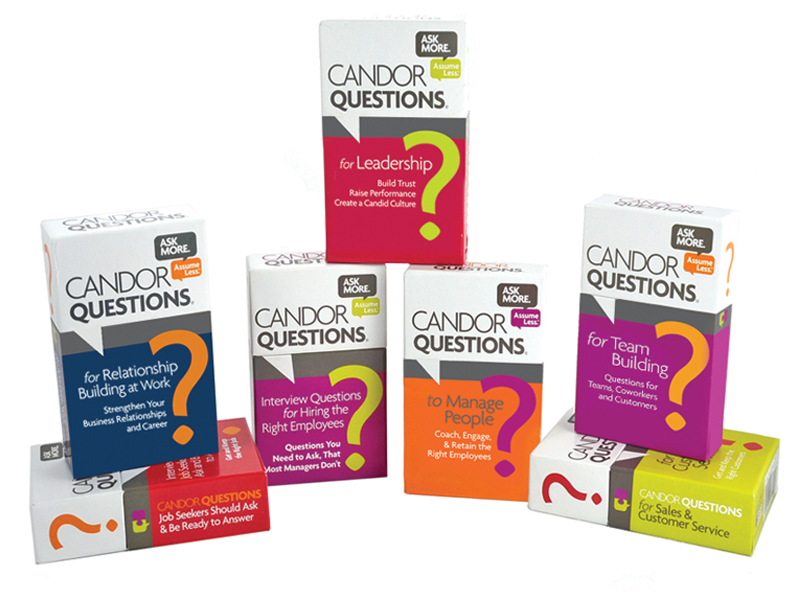USING THE CANDOR QUESTIONS®
Introducing the Candor Questions:
- Introduce the Candor Questions verbally, versus in writing, then give people the cards to prepare for the conversation.
- Don’t require answers in writing. It makes people suspicious.
- If people want to provide written answers, that’s fine, but don’t require it.
When to use the Candor Questions:
- Job interviews
- New-employee orientation
- One-on-one meetings between employees and their managers
- Team, department, and project meetings
- Project kick off, planning, and debrief meetings
- Team builders
- Ice breakers
- Roundtable discussions with leaders
- Town hall meetings
Instructions for Using the Candor Questions:
- Start your team meetings with one question per meeting. Everyone at the meeting answers the question. Then move on to your meeting agenda. Repeat at the next meeting.
- Use the questions during one-on-one meetings. Ask up to five questions during each meeting.
- Use the questions with groups of up to eight people. The conversation typically gets too long in larger groups. If you have a large team, break people into smaller groups.
- Get two teams or departments together to learn more about each other’s work and how departments can work together.
- Get one or more liaisons from different departments together to ask the questions of each other, and then have the liaisons report back to their teams.
- Ask questions whenever you have them. The questions don’t have to be part of a formal process or meeting.
Candor Questions Q&A
Q: What happens if people don’t tell me the truth or say nothing? Do I still ask the questions?
A: Yes. You strengthen your relationships just by asking the questions. In the beginning, it’s less important that people answer your questions and more important that you took the time to ask. At some point, people may be comfortable giving you the information.
Q: Do I ask the questions individually or in groups?
A: Both. Working-style preference questions are perfect for both individual and group meetings. Feedback questions are likely better for one-on-one meetings. See page 23 for more information on how to use the Candor Questions.
Q: Which questions do I ask first?
A: Start with the easy, working-style preference questions and work your way up to the harder, feedback-oriented questions, when people are more comfortable with the process.
Q: Is it ok to show the cards during conversations, or will people find that weird?
A: Show the cards. People won’t find it weird. They’ll appreciate that you’re asking.
Q: What happens if people ask for something I can’t or don’t want to give them?
A: You can’t give people everything they ask for. Asking the questions gives you the chance to talk about people’s requests and needs, when you otherwise wouldn’t be able to have that conversation.
Q: How often should I ask the questions?
A: Asking the questions is not a one-time event. It’s an ongoing process that lasts as long as your relationships last. Ask for feedback at least quarterly. Ask working-style preference questions whenever you have them.




